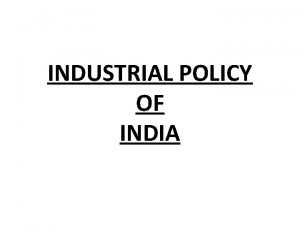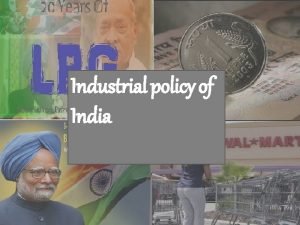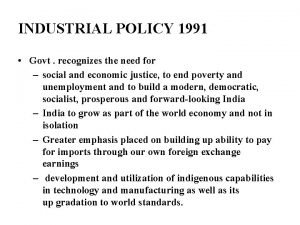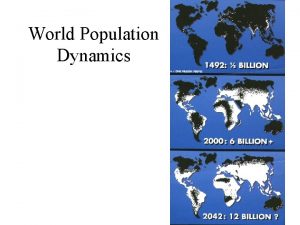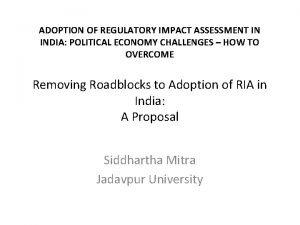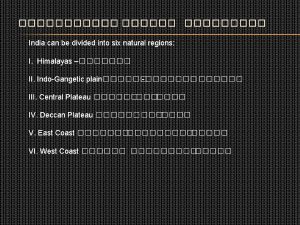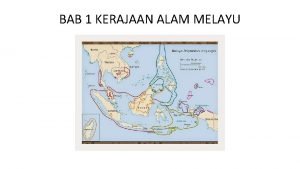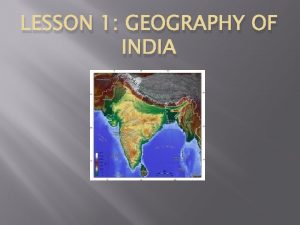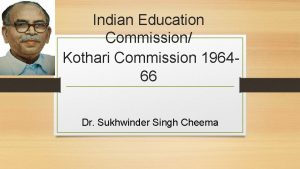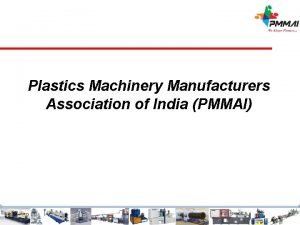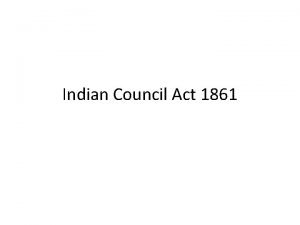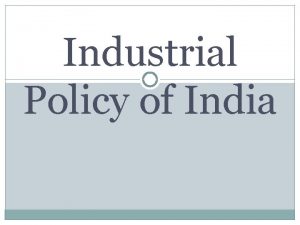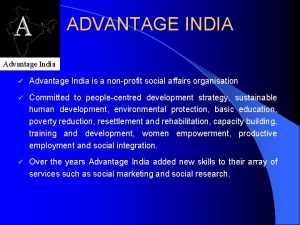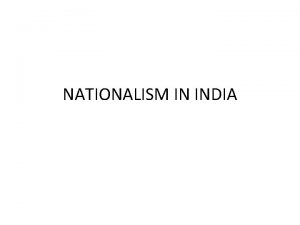Industrial policy of India INDUSTRIAL POLICY OF INDIA







































- Slides: 39

Industrial policy of India

INDUSTRIAL POLICY OF INDIA ANISHKUMAR. P. T ASSISSTANT PROFESSOR DEPARTMENT OF ECONOMICS NSS COLLEGE PANDALAM

INDUSTRIAL POLICY DEFINITION The concept of “industrial policy” is comprehensive and it covers all those procedures , principles , policies, rules and regulations which control the industrial undertaking of a country and shape the pattern of industrialization. It incorporates fiscal and monetary policies, the tariff policy, labour policy and governments attitude not towards external assistance but the public.

Industrial Policy resolutions Industrial policy resolution of 1948 Industrial policy resolution of 1956 Industrial policy resolution of 1973 Industrial policy resolution of 1977 Industrial policy resolution of 1980 NEW EONOMIC POLICY 1991

Industrial policy resolution of 1948 The most important policy statement of 1948 IPR are the following foundation. 1. Laid the foundation for Mixed economy 2. Industries were categorized in to 4 broad categories a. Industries which were to be the exclusive monopoly of the public sector. These were arms and ammunitions, defence production, production and distributon of automic energy, Railway transport and the like. . b. Industries in which new units could be started only by the Government, while existing units in the private sector allowed to continue. c. Industries which were left to the private sector where the central government could plan and regulate their functioning. 3. It recognized the importance of SSI 4. The importance of harmonious labour relations and the necessity to provide the labourers with fair working conditions were outlined in this policy. 5. Importance of foreign capital but on the hands of Indian personnel.

Industrial policy resolution of 1948 • Important distinction was made. Industries to be kept under : -public sector, -private sector and the -joint sector. • Industrial Department and Regulation Act (IDR Act) was enacted in 1951.

Objective of IDR 1951 Empowering the Government to take necessary steps to regulate the pattern of industrial development through licensing. • This paved the way for the Industrial Policy Resolution of 1956, which was the first comprehensive statement on the strategy for industrial development in India.

Industrial Policy Resolution - 1956 • Shaped by the Mahalanobis Model of growth, which suggested that emphasis on heavy industries would lead the economy towards a long term higher growth path. The Industrial Policy Resolution - 1956 classified industries into three categories : 17 industries : exclusively under the domain of the Government. These included inter alia, railways, air transport, arms and ammunition, iron and steel and atomic energy. 12 industries which were envisaged to be progressively State owned but private sector was expected to supplement the efforts of the State. The third category contained all the remaining industries and it was expected that private sector would initiate development of these industries but they would remain open for the State as well.

Objectives • To accelerate economic growth and boost the process of industrialization as a means to achieving a socialistic pattern of society. • Removal of regional disparities through development of regions with low industrial base.

Improving living standards and working conditions for the mass of the people. To reduce disparities in income and wealth. To prevent private monopolies and concentration of economic power in different fields in the hands of small numbers of individuals The State will progressively assume a predominant and direct responsibility for setting up new industrial undertakings and for developing transport facilities. At the same time private sector will have the opportunity to develop and expand. The adoption of the socialist pattern of society as the national objective.

Ø The IPR 1956 gave due recognition to the importance of SSI Ø The need for balanced regional development emphasized Ø Necessity to maintain and promote industrial peace and cordial relations between employers and employees as essential for industrial development. Ø The need for the development of technical and management education to meet the increasing requirements for such personnel by our industrial units.

INDUSTRIAL POLICY RESOLUTION, 1973 It provided for a closer interaction between the agricultural and industrial sectors. Accorded the highest priority to the generation and transmission of power. An exhaustive analysis of industrial products was made to identify products which are capable of being produced in the small scale sector. The list of industries exclusively reserved for the small scale sector was expanded from 180 items to more than 500 items. Within the small scale sector, a tiny sector was also defined with investment in machinery and equipment upto Rs. 1 lakh and situated in towns with a population of less than 50, 000 according to 1971 census figures, and in villages. Special legislation to protect cottage and household industries was also proposed to be introduced.

INDUSTRIAL POLICY RESOLUTION, 1977 The Government would promote the development of a system of linkages between nucleus large plants and the satellite ancillaries To boost the development of small scale industries, the investment limit in the case of tiny units was enhanced to Rs. 2 lakh, of a small scale units to Rs. 20 lakh and of ancillaries to Rs. 25 lakh. A scheme for building buffer stocks of essential raw materials for the Small Scale Industries was introduced for operation through the Small Industries Development Corporations in the States and the National Small Industries Corporation in the Centre. Industrial processes and technologies aimed at optimum utilisation of energy or the exploitation of alternative sources of energy would be given special assistance, including finance on concessional terms.

Ø This policy expanded the role of public sector not to produce important strategic goods but to ensure essential supplies to the consumers ØThe IPR 1977 was generally not in favor of foreign collaboration. ØThis policy made a selective approach to the problem of sick units.

INDUSTRIAL POLICY RESOLUTION 1980 Correction of regional imbalances; Maximum production and achieving higher productivity; Higher employment generation; Strengthening of the agricultural base through agro based industries; Promotion of export-oriented industries; Promotion of economic federalism through equitable spread of investment and dispersal of returns; Consumer protection against high prices and bad quality.

IPR 1980 Ø rejuvenate the public sector Ø and improve operational efficiency. Ø The policy aimed at integrating industrial development in the private sector By encouraging the concept of Economic federalism.

Ø The limits for SSI redefined • The limits for tiny sector was raised from 1 lakh to 2 lakhs. • To increase the limits of investment in the case of small scale units from 10 lakhs to 20 lakhs • To increase the limit of ancillaries from 15 lakhs to 25 lakhs Ø Special concessions were accorded to large scale units to improve their efficiency and employment potential. Ø Tightened the regulation towards the sick units.

New INDUSTRIAL POLICY 1991

�The spread of industrialization to backward areas of the country will be actively promoted through appropriate incentives, institutions and infrastructure investments. �Foreign investment and technology collaboration will be welcomed to obtain higher technology, to increase exports and to expand the production base. �Abolish monopoly �Workers’ participation in management will be promoted

INDUSTRIAL POLICY 1991 ISSUES § Government recognizes the need for • social and economic justice, to end poverty and unemployment and to build a modern, democratic, socialist, prosperous and forward-looking India • India to grow as part of the world economy and not in isolation § Enhanced support to the small-scale sector so that it flourishes in an environment of economic efficiency and continuous technological up gradation § Emphasis on building our ability to pay for imports through our own foreign exchange earnings

INDUSTRIAL POLICY 1991 OBJECTIVES A. B. C. D. E. In pursuit of the above objectives, Government have decided to take a series of initiatives in respect of the policies relating to the following areas: Industrial Licensing. Foreign Investment. Foreign Technology Agreements. Public Sector Policy. MRTP Act.

A. Industrial Licensing: q Industrial licensing abolished for all projects except a short list of 18 industries related to security and strategic concerns, social reasons, hazardous chemicals etc. (Annex II) q Areas where security & strategic concerns predominate, reserved for public sector. (Annex I) q In projects where imported capital goods are required, automatic clearance given. q In locations other than cities of more than 1 million population, no requirement of obtaining industrial approvals from Central Government. q Incentives & investments in infrastructural development, to promote dispersal to rural and backward areas. q Existing units enabled to produce any article without additional investment.

INDUSTRIAL POLICY 1991 B. Foreign Investment: q Approval upto 51 percent foreign equity in high priority industries. (Annex-III) q Imports governed by general policy applicable to other domestic units, payment of dividents monitored by RBI to ensure that outflows on account of dividents are balanced by export earnings. q Other foreign equity proposals, not covered above, need prior clearance. q A special Empowered Board- to negotiate with a number of large international firms & get FDIs approved.

INDUSTRIAL POLICY 1991 Foreign Technology Agreements: q Automatic permissions foreign technology agreements in high priority industries (Annex -III) upto a lumpsum payment of Rs. 1 crore. q For industries other than those in Annex III, automatic permissions if no foreign exchange is required for payment q All other proposals need specific approval q No permission foreign technicians, foreign testing of indigenously developed technologies. C.

INDUSTRIAL POLICY 1991 D. Public Sector Policy: q Portfolio of public sector investments reviewed with a view to focus public sector on strategic, high tech & essential infrastructure. q Chronically sick public enterprises, referred to Board of Industrial & Financial Reconstruction (BIFR). q A part of government’s shareholding in public sector offered to mutual funds, financial institutions, public & workers. q Boards of public sector companies- more professional & powerful. q MOU system- managements would be granted greater autonomy & held accountable.

INDUSTRIAL POLICY 1991 E. MRTP Act: (Monopolistic Restrictive Trade Practices): q Removal of threshold limits of assets in respect of MRTP Companies & dominant undertakings. q Elimination of need of prior approval of Central Government for establishment, expanding, merger, amalgamation & takeover. q Emphasis on controlling & regulating monopolistic, restrictive & unfair trade practices. q Enabling the MRTP Commission to exercise punitive & compensatory powers.



POST 1991 THE REFORM PHASE

EIGHTH FIVE YEAR PLAN (1992 -97) Expectation- 7. 5 per cent Annually achieved growth rate for industries: 1992 -93 : 4. 2 percent 1993 -94 : 6. 8 percent 1994 -95 : 9. 4 percent 1995 -96 : 12. 3 percent 1996 -97 : 7. 7 percent Average Annual Growth Rate- 8. 1 percent

NINTH FIVE YEAR PLAN (1997 -2002) Industrial growth target: 3% p. a. Achieved: 4. 5% p. a. In 1997 -98 and 1998 -99, industries reported a growth of 3. 8 percent. Such slow down was due to a number of structural and cyclical factors.

TENTH FIVE YEAR PLAN (2002 -07) Two major reforms that took place from the year 2002 were: 1)1. RISE IN INTERNATIONAL COMPETITION : Removal of quantitative restrictions on imports. 2)DECLINE IN ROLE OF PUBLIC SECTOR : Disinvestment process converted many of the existing public sector enterprises into nongovernmental enterprises.

INDUSTRIAL GROWTH RATES ANNUALLY : 2002 -03 : 6. 8 percent 2003 -04 : 7. 9 percent 2004 -05 : 8. 9 percent 2005 -06 : 8. 2 percent 2006 -07 : 10. 6 percent


ELEVENTH FIVE YEAR PLAN (2007 -12) Fluctuating trends 2007 -08: 15. 5 percent Started declining owing to global economic meltdown 2008 -09 : 2. 5 percent 2009 -10 : 5. 3 percent 2010 -11 : 8. 2 percent 2011 -12 : 3. 8 percent

India ease of business ranking 142 (2015) TOPICS DB 2015 Rank DB 2014 Rank Change in Rank Starting a Business 158 156 -2 Dealing with Construction Permits 184 183 -1 Getting Electricity 137 134 -3 Registering Property 121 115 -6 36 30 -6 7 21 14 Paying Taxes 156 154 -2 Trading Across Borders 126 122 -4 Enforcing Contracts 186 Resolving Insolvency 137 135 Getting Credit Protecting Minority Investors out of 189 economies Source: world bank No change -2


TWELVTH FIVE YEAR PLAN (2012 -17) CHALLENGES FACING : A. Dumping in Indian markets B. Indian Industry needs to be cost effective along with delivering value. C. Ensuring that investments made in infrastructure projects fructify quickly. D. Growth of labour intensive industries.

ACTIVITY : POLICY DILEMMA • • Khadi, which symbolized self-reliance and emancipation during the freedom struggle in India, has lost its sheen over the years. In 1957, the Khadi and Village Industries Commission (KVIC) was established to take over the work of the board. KVIC was formed as a nodal agency to promote Khadi all over India through its exclusive outlets known as Khadi Bhandars. There were many bogus Khadi units operating in the country, which made it extremely difficult to claim rebates from the Government of India for the sale of Khadi. • You are the Home Minister of INDIA. Prepare a clause in the existing Industrial Policy of India to deal with the above stated problem.
 Industrial policy resolution in india
Industrial policy resolution in india Introduction to industrial relations
Introduction to industrial relations Industrial relations in india
Industrial relations in india Industrial policy
Industrial policy Industrial policy
Industrial policy Lesson 2: india seeks self-rule
Lesson 2: india seeks self-rule Indus valley resources
Indus valley resources Www.hfc-workshop.com
Www.hfc-workshop.com Danish settlements in india
Danish settlements in india Welcome to india presentation
Welcome to india presentation Who was the first prime minister of india
Who was the first prime minister of india Techyons
Techyons Issues in curriculum development in india
Issues in curriculum development in india India religion map 2021
India religion map 2021 Maldives groupon
Maldives groupon Father of indian pediatric dentistry
Father of indian pediatric dentistry Population explosion in india
Population explosion in india British east india company
British east india company Humboldt wedag india pvt ltd delhi
Humboldt wedag india pvt ltd delhi Indian social classes
Indian social classes Friendly takeover
Friendly takeover Hitachi zosen india
Hitachi zosen india Tri kang sinangguh guru
Tri kang sinangguh guru Regulatory impact assessment india
Regulatory impact assessment india National programmes related to nutrition
National programmes related to nutrition India is divided into how many natural territories
India is divided into how many natural territories Three sections of northern plains
Three sections of northern plains Religion in india
Religion in india Apakah maksud alam melayu
Apakah maksud alam melayu Ernet india
Ernet india Is india a limited or unlimited government
Is india a limited or unlimited government Bronze age weapons
Bronze age weapons Tahun baru india dirayakan pada
Tahun baru india dirayakan pada Similes in the poem taj mahal
Similes in the poem taj mahal Continent of india
Continent of india Sageny
Sageny The kothari commission
The kothari commission Plastics machinery manufacturers association of india
Plastics machinery manufacturers association of india Indian councils act of 1861
Indian councils act of 1861 Phwr reactor in india
Phwr reactor in india
